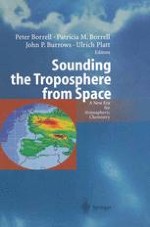2004 | OriginalPaper | Chapter
Determination of NOx Sources by Combination of Satellite Images with Transport Modelling
Authors : Andreas Stohl, Nicole Spichtinger, Steffen Beirle, Mark Wenig, Thomas Wagner, Ulrich Platt
Published in: Sounding the Troposphere from Space
Publisher: Springer Berlin Heidelberg
Included in: Professional Book Archive
Activate our intelligent search to find suitable subject content or patents.
Select sections of text to find matching patents with Artificial Intelligence. powered by
Select sections of text to find additional relevant content using AI-assisted search. powered by
Tropospheric nitrogen oxides (NOX) play a key role in tropospheric photochemistry, being a limiting factor of tropospheric ozone production. NOX have various sources with highly uncertain magnitudes. Therefore, the main task of our work is to combine GOME satellite image sequences with Lagrangian transport models to determine tropospheric NOX sources. We focussed on case studies on different NOX sources. So far we investigated biomass burning, NOX industrial, NOX and lightning NOX. To simulate the atmospheric transport of these emissions we used the Lagrangian particle dispersion model FLEXPART (see http://www.fw.tum.de/EXT/LST/METEO/stohl).Firstly, we investigated transport of NOX emissions from Canadian forest fires during August 1998 (Spichtinger et al. 2001), using a dispersion model calculations, Total Ozone Mapping Spectrometer (TOMS) aerosol index data, and tropospheric NO2 columns derived from the GOME satellite data. We tracked an NOX plume from forest fire hot spots, via the Atlantic Ocean, to the west coast of Europe. An NO2 plume, comparable in magnitude to values over major anthropogenic emission regions, was found in the GOME data over the largest fire. This plume could be traced to Greenland on subsequent days. A weaker signal, very likely also due to the forest fires, was detected over the Atlantic Ocean and even close to Europe.Secondly, we studied intercontinental transport of nitrogen oxides from South African power plants to Australia in May 1998. This episode was also simulated with FLEXPART, which used NOX emissions from the Global Emissions Inventory Activity (GEIA). Emission densities of the highly industrialised Highveld are among the highest in the world. Additionally, lightning emissions were added by utilising LIS data. Lightning NOX amounted to around 10% of the simulated concentrations. Recently, the forest fire analysis was extended to a climatology of the fire seasons 1997 and 1998 with a focus on Siberian forest fire emissions. The fire season (May to October) of 1998 was, in contrast to 1997, very intense and dominated by very high fire activity in both Canada and Siberia. Transport of forest fire emissions was simulated with FLEXPART over the whole burning season 1998. NOX was emitted from Siberian and Canadian forest fires according to the fire information from ATSR. The FLEXPART simulation shows that the strong boreal forest fires in 1998 enhanced both the TOMS aerosol index as well as GOME tropospheric column densities.Due to considerable uncertainties in the satellite data, in the chemical partitioning of NOy, and wet and dry removal thereof, and unknown variations in fire intensity the results are rather qualitative. Climatalogical investigations and the quantification of NOX emissions are our main future tasks.
